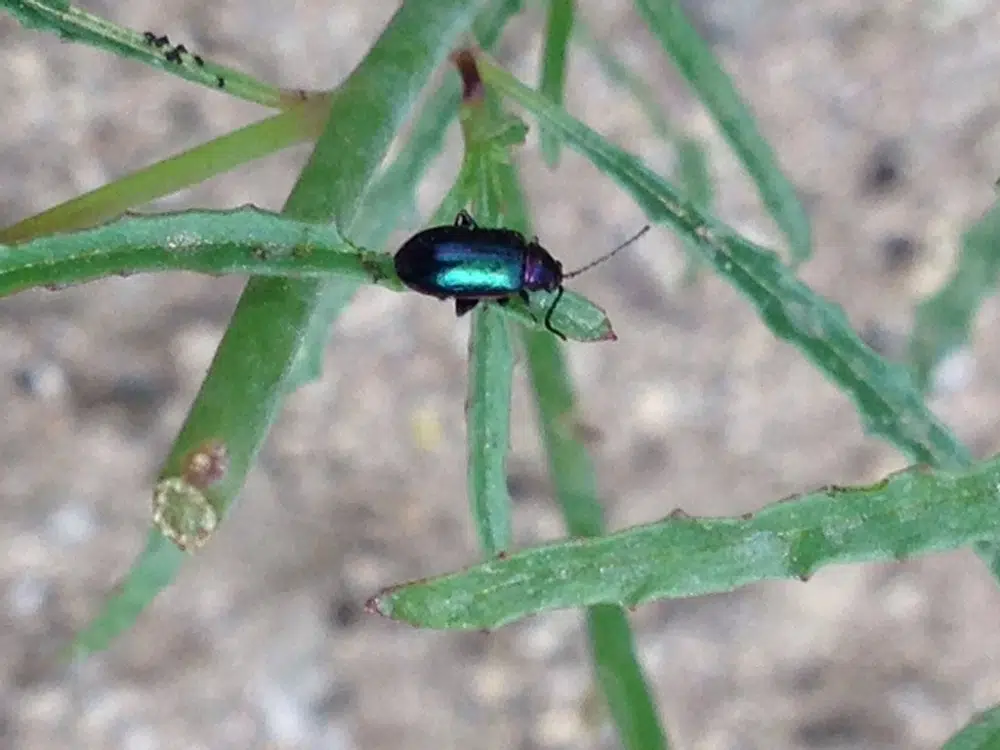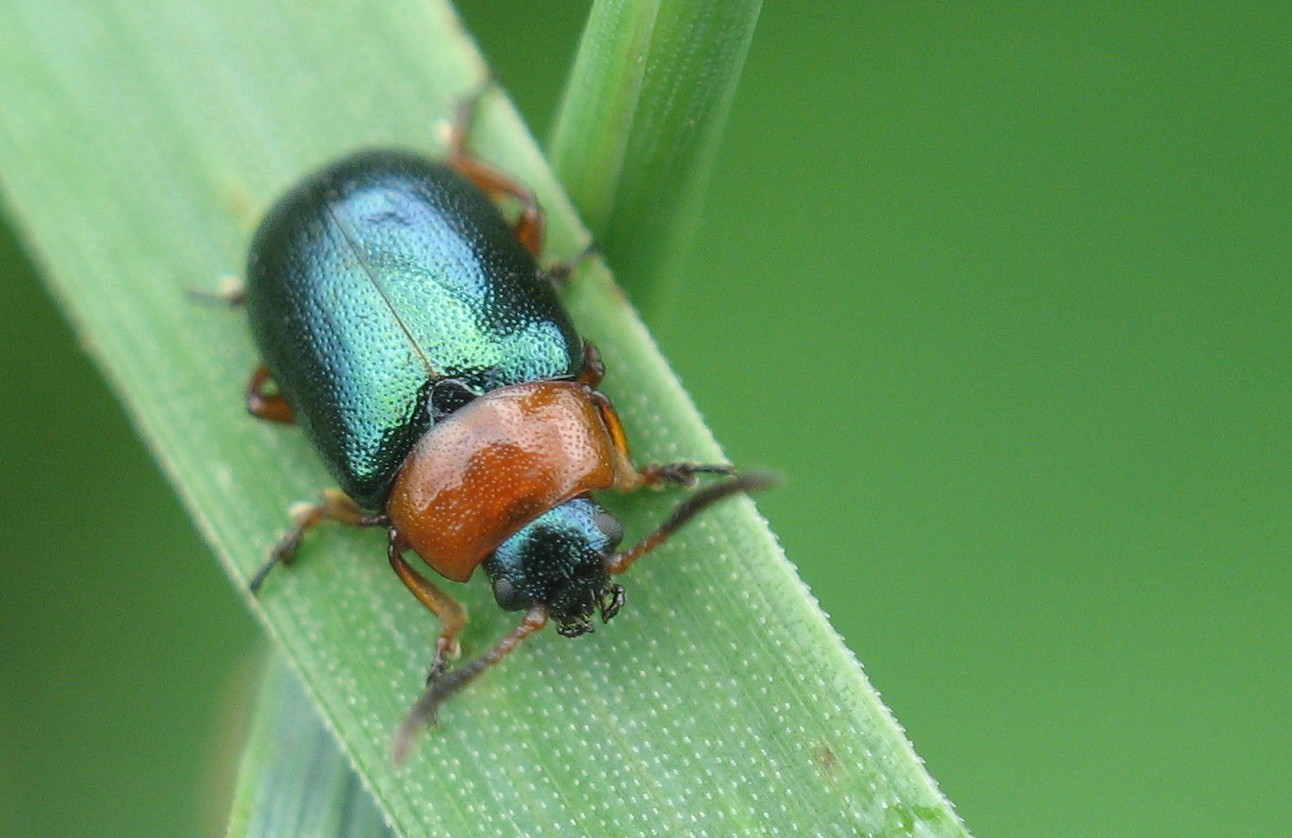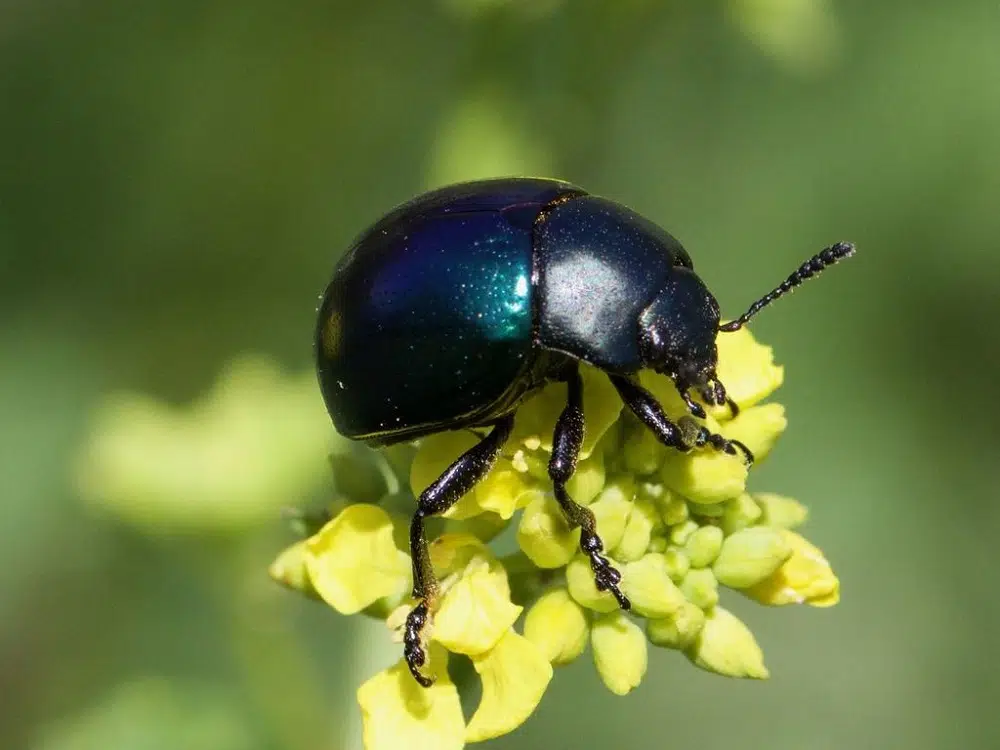Beetles are found all around the world. Blue beetles immediately stand out compared to black beetles.
These bugs can feed on pollen but they can also be carnivores.
Blue beetles grow to a size of up to 1.5-1.7 inches and can be diurnal or nocturnal.
Many blue beetles are parasites, particularly in their larval stage. Other species are important pollinators as they move along for pollen from one flower to another.
Here are some of the most common blue beetles around the world.
Table of Contents
1. Blue Fungus Beetle
The Blue Fungus Beetle (Cypherotylus californicus) is a North American native species. Found in high numbers in Southern states, this is a mostly blue beetle.

A dark blue elytron is seen on the species. It features tiny black dots. The head and the legs of the bug are also black.
These beetles darken with age but they start life as light blue or light gray beetles while their larvae are mostly black.
Beetles of this genus are found in areas with high moisture that favor fungus growth. Conk fungus is the main food source for the Blue Fungus Beetle which also inspires its name.
2. Willow Leaf Beetle

This species of beetle (Plagiodera versicolora) has a dark blue metallic color. It represents an introduced species to North America with a widespread presence on the Eastern side of the continent.
Characterized by uniform dark blue coloring across its body, the species gets its name from the willow tree it lives on.
It consumes the tree leaves being a mild pest as it skeletonizes the leaves.
3 generations of Willow Leaf Beetles are seen each year, up to the end of the summer.
You can find the beetle in riparian areas and other areas where willows are common.
3. Cobalt Milkweed Beetle

This species of beetle (Chrysochus cobaltinus) have a cobalt-blue color and feed on milkweed, as its name implies.
They also feed on dogbane and can be found in Western US territories. Its species in Eastern territories are called Dogbane beetles.
This species has a metallic cobalt-blue color without any spots.
It feeds on milkweed and dogbane both as larvae and into adulthood.
The leaves of these plants are consumed almost completely by these bugs.
You can find the species in almost all habitats rich in milkweed West of The Rocky Mountains. It grows to a size of up to 0.3 inches.
4. Flower Lebia Beetle

This type of beetle (Lebia viridis) is known for its cobalt-blue color or metallic blue-green color.
Beetles of this genus have the same blue nuance across the elytra and the head while their legs are black.
The size of the species is also atypical as these beetles only grow to a maximum size of 7mm.
Southern US territories, Mexico, and Cuba are all common habitats of the species.
This beetle is mostly found in different types of flowers, mostly white or yellow flowers.
Spiders and birds are amongst its most common predator species.
5. Desert Ironclad Beetle

This type of blue beetle (Asbolus verrucosus) has a very limited range across North America.
It’s only found in Southern desert climates such as in The Mojave Desert.
The species has a muted blue color or a mate blue color with gray undertones, specific to its arid climate.
It also represents one of the blue beetles which also has blue legs.
The species grows to a size of at least 18mm.
Desert Ironclad Beetles are mostly seen in captivity, raised as pets, due to their ability to play dead.
These bugs raise their legs and fake their death in the face of potential predators.
6. Blue Dock Beetle

This species (Gastrophysa cyanea) grows to a minimum size of 4mm. It has a blue-green metallic color that covers both the head and the elytra.
Beetles of the species are commonly found feeding on curly dock plants.
You can identify females with their swollen bodies as they prepare to lay eggs. The body of the female is blue-black or green-black.
It has more black sections due to its swollen body.
This species is seen early in the season, up until late summer. It appears in March-April intervals across the country.
7. Metallic Blue Lady Beetle

This species of lady beetle (Curinus coeruleus) is seen across North and Central America.
It’s among the most common small predatory bugs in the country. A dark blue color is specific to the species.
These bugs appear almost black due to their dark navy blue nuance.
Orange spots contrast the dark blue coloring of the beetle.
Like most lady beetles, the Metallic Blue Lady Beetle is a predator species.
It feeds on many smaller and larger insects compared to its size.
Scale insects are among its favorites.
Beetles of this species are also used as control agents on crops. They tend to have high success against aphids that feed on legumes.
8. Redlegged Ham Beetle

Redlegged Ham Beetles (Necrobia rufipes) are among the most common blue species used in forensics to determine the time of death.
These beetles feed on the flies that eat decaying meats and their larvae feed on meats and bones.
Bugs of this genus have an elongated body with small punctures. A blue-green metallic color is specific to this species.
Redlegged Ham Beetles grow to a maximum size of up to 0.3 inches.
The bug is a common sight in areas with dried meats or smoked meats which it bores. Salt meats and smoked fish are among its most common foods and habitats for laying and larvae.
9. Blue-Green Citrus Root Weevil

Blue and green colors are specific to these beetles (Pachnaeus litus). The male has light blue coloring with black marks and dots.
As its name implies, it’s a common pest of citruses. However, these beetles are also ready to eat all types of host plants in the extended citrus family.
One of the biggest issues with the species is that its larvae feed on the roots of plants.
All plant damages aren’t easily visible at the moment. These plants only show health concerns once their roots have been deeply affected.
Pine land and marshes are common habitats for the species that only live in Florida on US territory.
10. Steelblue Lady Beetle

This species of beetle (Halmus chalybeus) is known for its deep blue color. Its body has a metallic blue color with black undertones.
The shiny beetle has a round shape, similar to most lady beetle.
A common sight across New Zealand, the bug has since made it around the world.
Like other beetles, it has predatory behavior. It eats other insects and it’s considered a beneficial beetle.
Scale insects are among its common meals.
Beetles of this family consume all types of scale insects including pest-status insects such as gum scales.
You can find this species in all areas where scale insects live.
The round blue beetle grows to a size of up to 4mm.
11. Short-winged Blister Beetle

This ground-dwelling species (Meloe angusticollis) is one of the blue-black beetles with uncommon self-defense tactics.
Oil drops are released by this species whenever under threat. It releases 2 to 4 oil drops with an unpleasant smell which aims to make predators move along.
The species has a very dark blue color, often confused with other black beetles.
While its wings are dark blue, the abdomen has a lighter shade of blue, also of a metallic nuance.
The species is small but comparable in size to other beetles that are blue
The maximum size of 0.4 inches is specific to the Short-winged Blister Beetle.
12. Steel-blue grapevine flea beetle

Southern Arizona and other extreme Southern US territories are the home of this species (Altica torquata).
Steel-blue grapevine flea beetles are also highly common in Northern Mexico.
This species has a blue color which may also be closer to green among females.
Its metallic color makes the blue nuance look richer. Females have green nuances but blue tones are seen on the edges of the wings.
The head of the species is also similarly colored to the rest of the body.
As the name implies, these types of blue beetles are a common sight among grapevines and even other types of vines that they consume and are a pest.
13. Philonthus caeruleipennis

This atypically-shaped bug has a blue color across its thorax, a black abdomen, and a black head.
Mostly resembling earwigs, the species has an elongated abdomen with pincer-like filaments at the end of the abdomen.
The blue nuances on its body have green hues with a shiny metallic finish.
Bugs of this genus also have long black antennae.
You can find the beetles of this family across Northeastern Canada and Northern US territories.
The species appears in May with an active season that reaches the beginning of October.
14. Pine Trogossitid Beetle

These types of beetles (Temnoscheila chlorodia) live secretive lives as they’re mostly found under tree bark. Dead trees are the only hosts of the species which means they aren’t a threat to pine trees.
Native to North America, Pine Trogossitid Beetles are some of the largest blue beetles since some bugs of this species reach a size of 20mm.
A metallic blue color with green undertones is specific to the Pine Trogossitid Beetle.
There are at least 2 broods of the species in warm areas of North America such as Nevada. The first brood is seen in the spring while the second brood appears at the beginning of August.
15. Knotweed Leaf Beetle

Mostly seen on knotweed and knotgrass, the Knotweed Leaf Beetle (Gastrophysa polygoni) is a species native to Europe and North America.
It has a round shape and an average size of 5mm.
Its color is mostly blue with a metallic hue. The species has a black and brown cephalothorax.
Feeding on leaves, the species is mostly seen in 2 broods each year.
It first appears in the spring with a second brood visible in late summer.
The species is part of a group of non-predatory beetles that only feed on plants.
16. Platycorynus peregrinus
This species of blue beetle has a medium size with many individuals measuring up to 11.5mm.
Its blue nuance has black and metallic undertones.
Some perforation-like protrusions are seen across its body.
The uniform coloring covers its body and its head while its legs and antennae are black.
Seen on multiple continents, this species is also known to feed on some of the most toxic plants of the Apocynaceae family.
Absorbing these toxins, the beetle can have a bad taste that keeps many of its predators away.
17. Violet Oil Beetle

Violet Oil Beetles (Meloe violaceus) are some of the largest parasitic blue beetles in the world.
They reach a size of up to 1.2 inches and their parasitism has been tied to multiple species of bees, mainly among the solitary species.
Beetles of this genus eat pollen as adults but they show parasitism behavior as larvae.
Adults lay eggs in the nest of solitary bees. These eggs may accidentally end up in bee hives as well.
In this case, the larvae die, but not before creating considerable losses among bee colonies.
One of the reasons the Violet Oil Beetle is so damaging is that females tend to lay eggs in their thousands.
This means the larvae exterminate solitary bee nests in a given perimeter easily.
18. Alder Leaf Beetle

These types of beetles (Agelastica alni) have a uniform blue color with a shiny glow. They also have blue legs and blue antennae.
Native to Europe and North America, Alder Leaf Beetles are among the species damaging alder trees.
While these damages are rarely considered, the species can be seen feeding on the leaves of various alders.
As with other blue beetles, it’s the larvae that cause much of the host tree problems as opposed to the adults.
You can see this type of beetle in North America appearing in one generation alone. Adults of the species rarely grow to a size larger than 6mm.
19. Hoplia coerulea

This type of beetle is native to Europe. It has coloring differences between the sexes as females are brown.
Males of the species have a composed vivid color.
Blue is dominant across its body. Purple and pink hues are also seen along the male’s body.
The species tends to darken in time, slowly becoming mate blue and partly black.
You can find these beetles just above the ground as they feed on low grasses.
20. Alpine Longhorn Rosalia

This type of beetle (Rosalia alpina) is only seen in Europe.
It’s found in woodlands where the European beech is found in high numbers.
Blue color with black patterns is specific to the Alpine Longhorn Rosalia.
This species is very large, with a maximum length of up to 38mm. Its long antennae also measure at least 50mm, being longer than its body.
You can find the beetle is active until September.
21. Blue Ground Beetle

These beetles (Carabus intricatus) reach a maximum size of up to 1.4 inches and are European natives.
A blue-black color is specific to the species.
Blue Ground Beetles are true carnivores. They live in forests and other humid habitats with plenty of slugs which they eat.
These beetles live long lives. Their life expectancy is 2 years, longer than in other beetles.
22. Mint Beetle

Mint Beetles (Chrysolina coerulans) are European natives.
These small bugs grow to a size of up to 0.5 inches and are characterized by a dark blue color with a metallic shine.
Various types of mint, including spearmint, are its main food source.
It can be found in all moist areas where mint grows. Even decorative mint in gardens is consumed by the bugs.
23. Haldeman’s Green Potato Beetle

The small beetle (Leptinotarsa haldemani) is named after its host potato plant. Further studies indicate potatoes are only its secondary host plant favorite.
Beetles of the genus are mostly found on nightshade.
They have a round dome-shaped body. A dark blue color is specific to the species according to its name.
24. Alder Flea Beetle

These types of small blue beetles (Altica ambiens) are among the main bugs seen on alder.
Leaves of alder trees are among the main food sources of the species. Alder Flea Beetles will eventually kill alder trees if left unmanaged.
The first signs of the Alder Flea Beetle include skeletonized tree leaves.
25. Steely Blue Beetle

This type of blue beetle (Korynetes caeruleus) shows parasitic behavior within its larvae stage.
Females seek out trees infested by the common furniture beetle and lay eggs within the tunnels dug by the bug.
Emerging larvae feed on these bugs until pupating.
26. Blue Monkey Beetle

This species (Scelophysa trimeni) is mostly native to South Africa.
It can be found on daisies and other unscented flowers which they use as a source of pollen.
Blue Monkey Beetles are among the smallest blue beetles in the world. They grow up to a size of 10mm.
While seen on flowers, these small beetles have known pollinators across South Africa.